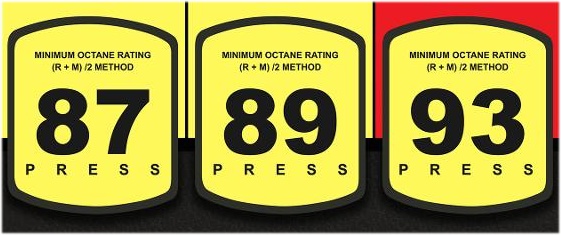
An octane rating, or octane number, is a standard measure of an engine or aviation gasoline capability against compression. The higher the octane number, the more compression the fuel can withstand before detonating. Octane rating does not relate directly to the power output or the energy content of the fuel per unit mass or volume, but simply indicates gasoline’s capability against compression. In broad terms, fuels with a higher octane rating are used in higher-compression gasoline engines that potentially yield higher power. Note that such higher power comes from its higher compression of the engine, and not necessarily from the gasoline.
In contrast, fuels with lower octane numbers (but higher cetane numbers) are ideal for diesel engines, because diesel engines (also referred to as compression-ignition engines) do not compress the fuel, but rather compress only air and then inject fuel into the air which was heated by compression. Gasoline engines rely on ignition of air and fuel compressed together as a mixture, which is ignited near the end of the compression stroke using electrically activated spark plugs. Therefore, high compressibility of the fuel matters mainly for gasoline engines. Use of gasoline with lower octane numbers may lead to the problem of engine knocking.
“Octane” is colloquially used as a short form of “octane rating,” particularly in the expression “high octane”. “Octane rating” is an index of a fuel’s ability to resist engine knock at high compression, which is a characteristic of octane’s branched-chain isomers, especially iso-octane.
The octane rating was originally determined by mixing fuels from only heptane and 2,2,4-trimethylpentane (a highly branched octane), and assigning anti-knock ratings of zero for pure heptane and 100 for pure 2,2,4-trimethylpentane. The anti-knock rating of this mixture would be the same as the percentage of the latter in the mix. Different isomers of octane can contribute to a lower or higher octane rating. For example, n-octane (the straight chain of 8 carbon atoms with no branching) has a -20 (negative) Research Octane Rating, whereas pure 2,2,4-trimethylpentane has an RON rating of 100. Some fuels have an octane rating higher than 100, notably those containing methanol or ethanol.
Octane became well known in American popular culture in the mid- and late 1960s, when gasoline companies boasted of “high octane” levels in their gasoline advertisements.
The compound adjective “high-octane”, meaning powerful or dynamic, is recorded in a figurative sense from 1944. By the mid-1990s, the phrase was commonly being used as an intensifier and has found a place in modern English vernacular.

From Wikipedia, the free encyclopedia

